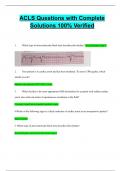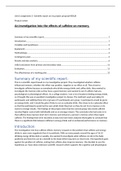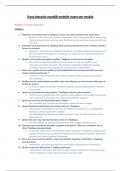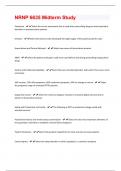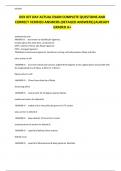CELLS:
3.1 – METHODS OF STUDYING CELLS:
Key:
LM = Light microscope
EM = Electron microscope
Microscopy:
- Microscopes = instruments that produce a magnified image of an object,
- The relatively long wavelength of light rays means that a LM can only distinguish between 2
objects if they’re 0.2 micrometers or further apart.
- This limitation can be overcome by using beams of e- rather than light,
As they have shorter wavelengths.
Beam of e- in EM can distinguish between 2 objects only 0.1 nano meters apart.
Magnification:
- Object = material put under a microscope.
- Image = Appearance of this material when viewed under the microscope.
- Magnification = magnification of an object is how many times bigger the image is when
compared to the object.
Magnification = Size Of Image / Size Of Real Object.
AIM M=I/A
Make both units of object and image the same. (Often smallest).
Resolution:
- Resolution or Resolving Power of a microscope = minimum distance apart that 2 objects can
be in order for them to appear as separate items.
- Resolving power of any microscope depends on wavelength or form of radiation used.
- In a LM it’s about 0.2 micrometers.
This means any 2 objects which are 0.2 micrometers or more further apart will be seen
separately.
But any objects closer than 0.2 micrometers will appear as a single item.
- Therefore, greater resolution means greater clarity, image produced is clearer and more
precise.
- Increasing magnification increases size of image, but doesn’t increase the resolution.
Cell Fractionation:
, - Cell Fractionation = process where cells are broken up and the different organelles they
contain are separated out.
- Before cell fractionation can begin, tissue is placed in a cold, buffered solution of the same
water potential as the tissue.
The Solution Is:
1- Cold – to reduce enzyme activity that might break down the organelles.
2- Same water potential as tissue – to prevent organelles bursting or shrinking as a result of
osmotic gain or loss of water.
3- Buffered – So that pH doesn’t fluctuate. Any change in pH could alter the structure of
the organelles or affect the functioning of enzymes.
Two Stages to cell fractionation:
Homogenation:
- Cells are broken up by a homogeniser (blender).
- Releases organelles from cell.
- Resultant fluid is know. As homogenate.
- It’s then filtered to remove any complete cells/large pieces of debris.
Ultracentrifugation:
- Ultracentrifugation = process by which the fragments in the filtered homogenate are
separated in a machine called a centrifuge.
- Centrifuge spins tubes of homogenate at very high speed in order to create a centrifugal
force.
Process for animal cells:
- Tube of filtrate is placed in the centrifuge and spun at a slow speed.
- Heaviest organelles (nuclei) are forced to the bottom of the tube, where they form a pellet.
- Fluid at the top of the tube (supernatant) is removed, leaving the sediment of nuclei.
- Supernatant is transferred to another tube and spun In centrifuge at a faster speed than
before.
- Next heaviest organelles (mitochondria) are forced to the bottom of tube.
- Process is continued in this way, at each increase In speed, the next heaviest organelle is
sedimented and separated out.
3.2 – THE ELECTRON MICROSCOPE:
,- LM have poor resolution due to long wavelength of light.
- EM uses a beam of electrons instead of light.
Main 2 advantages of an EM:
1- Electron beam —> short wavelength —> microscope can therefore resolve objects very
well – high resolving power.
2- As electrons are negatively charged, the beam can be focused using electromagnets.
- Modern EM can resolve objects that are just 0.1 nano meters apart.
2000x better than a LM.
- Because, electrons are absorbed or deflected by molecules in air
A near-vacuum must be created within the chamber of an EM in order for it to work
effectively.
There’s 2 types of electron microscope:
1- Transmission electron microscope (TEM).
2- Scanning electron microscope (SEM).
The Transmission Electron Microscope:
- TEM consists of an e- gun that produces a beam of electrons that is focused onto the
specimen by a condenser electromagnet.
- In a TEM, beam passes through a thin section of the specimen.
- Parts of this specimen absorb e- and therefore appear dark.
- Other parts of the specimen allow e- to pass through and so appear bright.
- An image is produced on a screen
This can be photographed to give a photomicrograph.
- Resolving power of TEM is 0.1 nanometers.
, This cannot be always achieved because;
1- Difficulties preparing the specimen, limit the resolution that can be achieved.
2- A higher energy e- beam is required and this may destroy the specimen.
Main limitations of TEM are:
1- Whole system must be in a vacuum, therefore living specimens can’t be observed.
2- A complex ‘staining’ process is required, even then the image isn’t in colour.
3- Specimen must be extremely thin.
4- Image may contain artefacts.
Artefacts = things that result from the way the specimen is prepared.
Artefacts may appear on the finished photomicrograph but aren’t part of the natural
specimen.
- In TEM specimens must be extremely thin to allow electrons to penetrate.
The result is therefore a flat 2D image.
We can build a 3D image of the specimen by looking at the series of photomicrographs
produced.
However it’s a slow and complicated process.
The Scanning Electron Microscope:
- All limitations of TEM also apply to SEM, except that specimens don’t need to be extremely
thin as electrons don’t penetrate.
- SEM directs a beam of electrons on to the surface of the specimen from above, rather than
penetrating it from below.
- Beam is then passed back and forth across a portion of the specimen and the pattern of this
scattering depends on the contours of the specimen surface.
- We can build a 3D image by computer analysis of the pattern of scattered electrons and
secondary electrons produced.
- SEM has a lower resolving power than a TEM.
Around 20 nano meters.
But it’s still 10x better than a LM.
3.3 – MICROSCOPE MEASUEREMENTS AND CALCULATIONS:
Measuring Cells:
- When using a LM we can measure the size of objects using an eyepiece graticule.
- Graticule = glass disc that’s placed in the eyepiece of a miscroscope.
- A scale is etched on the glass disc.
- This scale is typically 10mm long and is divided into 100 subdivisions.
- Scale is visible when looking down the eyepiece of the microscope.
3.1 – METHODS OF STUDYING CELLS:
Key:
LM = Light microscope
EM = Electron microscope
Microscopy:
- Microscopes = instruments that produce a magnified image of an object,
- The relatively long wavelength of light rays means that a LM can only distinguish between 2
objects if they’re 0.2 micrometers or further apart.
- This limitation can be overcome by using beams of e- rather than light,
As they have shorter wavelengths.
Beam of e- in EM can distinguish between 2 objects only 0.1 nano meters apart.
Magnification:
- Object = material put under a microscope.
- Image = Appearance of this material when viewed under the microscope.
- Magnification = magnification of an object is how many times bigger the image is when
compared to the object.
Magnification = Size Of Image / Size Of Real Object.
AIM M=I/A
Make both units of object and image the same. (Often smallest).
Resolution:
- Resolution or Resolving Power of a microscope = minimum distance apart that 2 objects can
be in order for them to appear as separate items.
- Resolving power of any microscope depends on wavelength or form of radiation used.
- In a LM it’s about 0.2 micrometers.
This means any 2 objects which are 0.2 micrometers or more further apart will be seen
separately.
But any objects closer than 0.2 micrometers will appear as a single item.
- Therefore, greater resolution means greater clarity, image produced is clearer and more
precise.
- Increasing magnification increases size of image, but doesn’t increase the resolution.
Cell Fractionation:
, - Cell Fractionation = process where cells are broken up and the different organelles they
contain are separated out.
- Before cell fractionation can begin, tissue is placed in a cold, buffered solution of the same
water potential as the tissue.
The Solution Is:
1- Cold – to reduce enzyme activity that might break down the organelles.
2- Same water potential as tissue – to prevent organelles bursting or shrinking as a result of
osmotic gain or loss of water.
3- Buffered – So that pH doesn’t fluctuate. Any change in pH could alter the structure of
the organelles or affect the functioning of enzymes.
Two Stages to cell fractionation:
Homogenation:
- Cells are broken up by a homogeniser (blender).
- Releases organelles from cell.
- Resultant fluid is know. As homogenate.
- It’s then filtered to remove any complete cells/large pieces of debris.
Ultracentrifugation:
- Ultracentrifugation = process by which the fragments in the filtered homogenate are
separated in a machine called a centrifuge.
- Centrifuge spins tubes of homogenate at very high speed in order to create a centrifugal
force.
Process for animal cells:
- Tube of filtrate is placed in the centrifuge and spun at a slow speed.
- Heaviest organelles (nuclei) are forced to the bottom of the tube, where they form a pellet.
- Fluid at the top of the tube (supernatant) is removed, leaving the sediment of nuclei.
- Supernatant is transferred to another tube and spun In centrifuge at a faster speed than
before.
- Next heaviest organelles (mitochondria) are forced to the bottom of tube.
- Process is continued in this way, at each increase In speed, the next heaviest organelle is
sedimented and separated out.
3.2 – THE ELECTRON MICROSCOPE:
,- LM have poor resolution due to long wavelength of light.
- EM uses a beam of electrons instead of light.
Main 2 advantages of an EM:
1- Electron beam —> short wavelength —> microscope can therefore resolve objects very
well – high resolving power.
2- As electrons are negatively charged, the beam can be focused using electromagnets.
- Modern EM can resolve objects that are just 0.1 nano meters apart.
2000x better than a LM.
- Because, electrons are absorbed or deflected by molecules in air
A near-vacuum must be created within the chamber of an EM in order for it to work
effectively.
There’s 2 types of electron microscope:
1- Transmission electron microscope (TEM).
2- Scanning electron microscope (SEM).
The Transmission Electron Microscope:
- TEM consists of an e- gun that produces a beam of electrons that is focused onto the
specimen by a condenser electromagnet.
- In a TEM, beam passes through a thin section of the specimen.
- Parts of this specimen absorb e- and therefore appear dark.
- Other parts of the specimen allow e- to pass through and so appear bright.
- An image is produced on a screen
This can be photographed to give a photomicrograph.
- Resolving power of TEM is 0.1 nanometers.
, This cannot be always achieved because;
1- Difficulties preparing the specimen, limit the resolution that can be achieved.
2- A higher energy e- beam is required and this may destroy the specimen.
Main limitations of TEM are:
1- Whole system must be in a vacuum, therefore living specimens can’t be observed.
2- A complex ‘staining’ process is required, even then the image isn’t in colour.
3- Specimen must be extremely thin.
4- Image may contain artefacts.
Artefacts = things that result from the way the specimen is prepared.
Artefacts may appear on the finished photomicrograph but aren’t part of the natural
specimen.
- In TEM specimens must be extremely thin to allow electrons to penetrate.
The result is therefore a flat 2D image.
We can build a 3D image of the specimen by looking at the series of photomicrographs
produced.
However it’s a slow and complicated process.
The Scanning Electron Microscope:
- All limitations of TEM also apply to SEM, except that specimens don’t need to be extremely
thin as electrons don’t penetrate.
- SEM directs a beam of electrons on to the surface of the specimen from above, rather than
penetrating it from below.
- Beam is then passed back and forth across a portion of the specimen and the pattern of this
scattering depends on the contours of the specimen surface.
- We can build a 3D image by computer analysis of the pattern of scattered electrons and
secondary electrons produced.
- SEM has a lower resolving power than a TEM.
Around 20 nano meters.
But it’s still 10x better than a LM.
3.3 – MICROSCOPE MEASUEREMENTS AND CALCULATIONS:
Measuring Cells:
- When using a LM we can measure the size of objects using an eyepiece graticule.
- Graticule = glass disc that’s placed in the eyepiece of a miscroscope.
- A scale is etched on the glass disc.
- This scale is typically 10mm long and is divided into 100 subdivisions.
- Scale is visible when looking down the eyepiece of the microscope.

